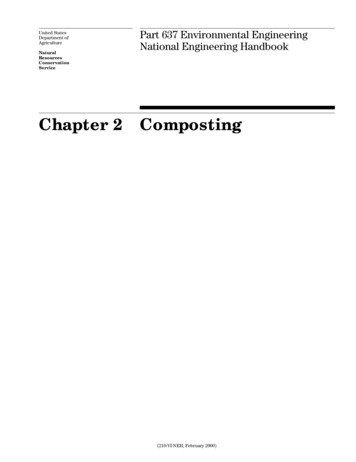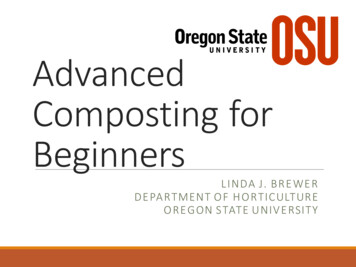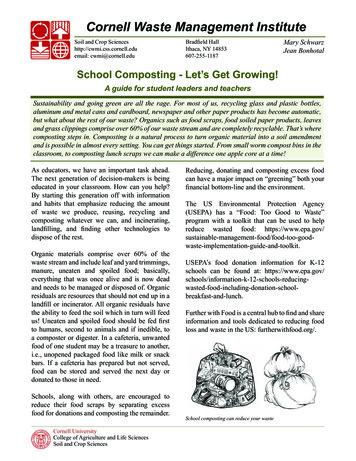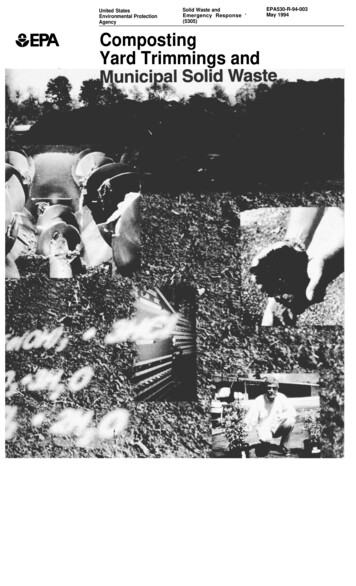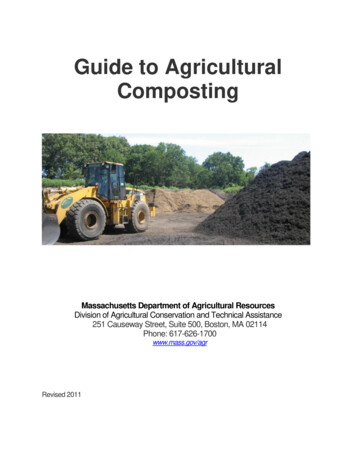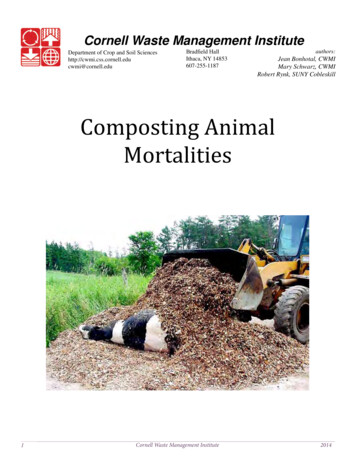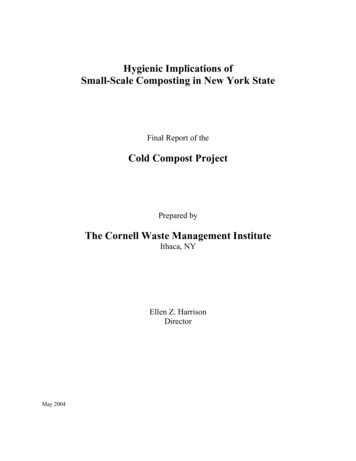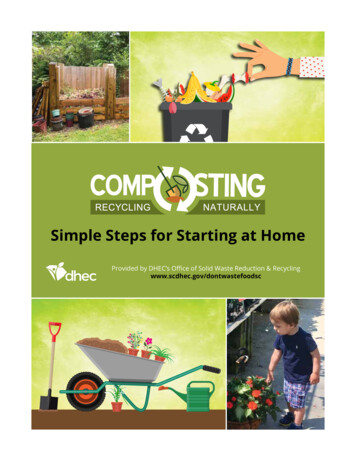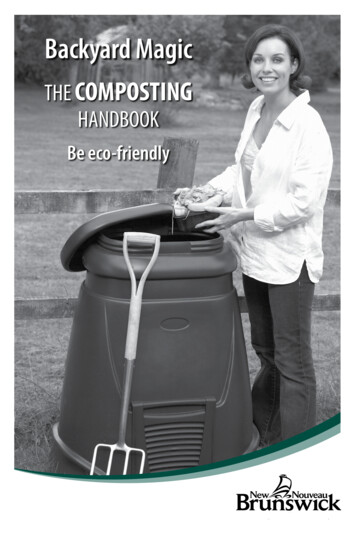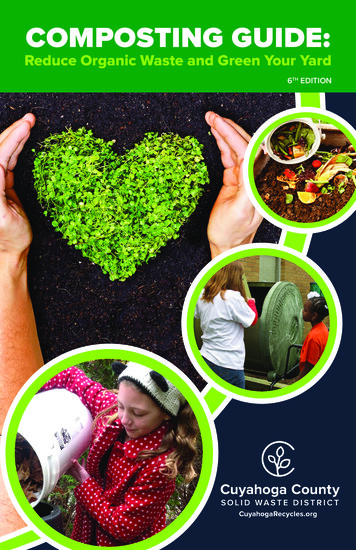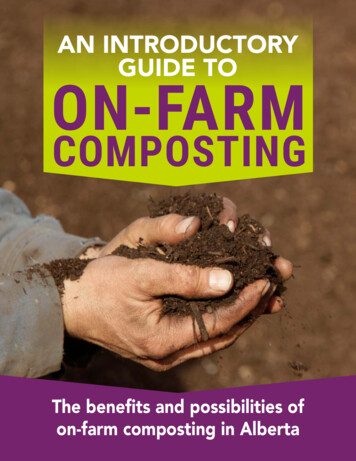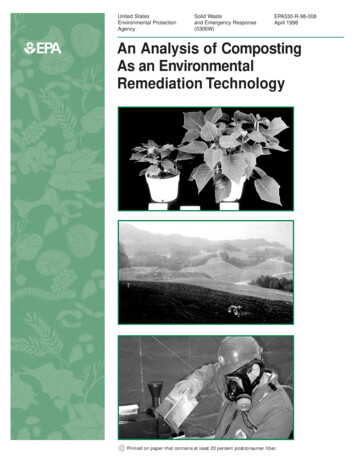
Transcription
United StatesEnvironmental ProtectionAgency1EPASolid Wasteand Emergency Response(5306W)EPA530-R-98-008April 1998An Analysis of CompostingAs an EnvironmentalRemediation Technology2 Printed on paper that contains at least 20 percent postconsumer fiber.
Chapter 1IntroductionThe composting process is currently viewed primarily as a waste management method tostabilize organic waste, such as manure, yard trimmings, municipal biosolids, and organicurban wastes. The stabilized end-product (compost) is widely used as a soil amendment toimprove soil structure, provide plant nutrients, and facilitate the revegetation of disturbed oreroded soil (Cole, 1994; Cole, 1995; Harmsen, 1994; McNabb, 1994). The information and datapresented in this document were compiled and analyzed by Michael A. Cole, Ph.D.Within the past few years, laboratory-, greenhouse-, and pilot-scale research has indicatedthat the composting process and the use of mature compost also provide an inexpensive andtechnologically straightforward solution for managing hazardous industrial waste streams (solid,air, or liquid) and for remediating soil contaminated with toxic organic compounds (such assolvents and pesticides) and inorganic compounds (such as toxic metals). For example, a largenumber of hydrocarbons, which are common industrial contaminants found in soil and exhaustgas, degrade rapidly during the composting process or in other compost-based processes.Furthermore, the addition of mature compost to contaminated soil accelerates plant andmicrobial degradation of organic contaminants and improves plant growth and establishment intoxic soils. When mature compost is added to contaminated soils, remediation costs are quitemodest in comparison to conventionally used methods. Mature compost also controls severalplant diseases without the use of synthetic fungicides or fumigants.This report summarizes the available information on the use of compost for managinghazardous waste streams (as well as other applications) and indicates possible areas for futureinvestigations. Attention to cross-media transfer of contaminants during implementation ofvarious bioremediation technologies presented in this report is recommended. A recentpublication by the U.S. Environmental Protection Agency (EPA), entitled Best ManagementPractices (BMPs) for Soil Treatment Technologies (EPA530-R-97-007, May 1997), could beconsulted to address the cross-media transfer concerns.An Analysis of Composting as an Environmental Remediation Technology1
The Composting ProcessComposting is a managed system that uses microbial activity to degrade raw organicmaterials, such as yard trimmings, so that the end-product is relatively stable, reduced inquantity (when compared to the initial amount of waste), and free from offensive odors.Composting can be done on a large or small scale, with the management requirements andintensity increasing dramatically as system size increases. In its simplest form, compostablematerial is arranged in long rows (windrows) and turned periodically to ensure good mixing(Figure 1). This process can handle large quantities of input, such as yard trimmings of up to100,000 cubic yards per year, on only a few acres of land.Raw materials that tend to be very odorous during composting, such as municipal wastesludge (biosolids), can be processed in more elaborate systems and in a confined facility whereodorous air can be treated. These systems use rotating drums, trenches, or enclosed tunnelsfor initial processing, followed by a covered curing period (Figures 2, 3, and 4). In addition, theBeltsville Agricultural Research Center in Beltsville, Maryland, developed a composting systemof intermediate complexity, between open-air windrows and the sophisticated systems shown inFigures 2 to 4 (Parr, 1978; Willson, 1980; U.S. EPA, 1985). The Beltsville system has severaldesirable features, and its generic design is adaptable to suit specific purposes. As shown inFigure 5, air is drawn through the compostable material and scrubbed of odorous compounds ina soil filter. Mature compost can be substituted for the soil filter. A compost filter has severaladvantages over a soil filter, including a higher adsorptive capacity for volatile organiccompounds (VOCs) and better air permeability properties. Compost filters are currently used inEurope at composting plants to eliminate nearly all volatile emissions.All composting methods share similar characteristic features and processes. Initially highmicrobial activity and heat production cause temperatures within the compostable material torise rapidly into the thermophilic range (50 o C and higher). This temperature range ismaintained by periodic turning or the use of controlled air flow (Viel, 1987). After the rapidlydegradable components are consumed, temperatures gradually fall during the "curing" stage(Figure 6). At the end of this stage, the material is no longer self-heating, and the finishedcompost is ready for use. Substantial changes occur in microbial populations and speciesabundance during the various temperature stages (Gupta, 1987). Mesophilic bacteria and fungiare dominant in the initial warming period, thermophilic bacteria (especially actinomycetes)during the high temperature phase, and mesophilic bacteria and fungi during the curing phase2An Analysis of Composting as an Environmental Remediation Technology
(Finstein, 1975). The resulting compost has a high microbial diversity (Beffa, 1996 andPersson, 1995), with microbial populations much higher than fertile, productive soils (Table 1)and many times higher than in highly disturbed or contaminated soils. Therefore, compostbioremediation takes far less time than natural attenuation of toxic materials (land farming).Microbial populations in soil (both fertile and contaminated) substantially vary from season toseason. In most cases, the addition of compost greatly increases microbial populations andactivity (Table 2). Since the microbes are the primary agents for degradation of organiccontaminants in soil (Alexander, 1994), increasing microbial density can accelerate degradationof the contaminants (Cole, 1994). In soil systems, microbial composition is greatly modified byorganic input composition (Martin, 1992 and Struwe, 1986); the same degree of variation canbe expected in composting systems. The impact of initial feedstock composition onmicroorganism development in compost needs to be further studied.Table 1Microbial Populations in Soil and Mature Yard Trimmings CompostMaterialBacteria(millions per gram dry weight)Fungi(thousands per gram dryweight)Fertile soila6 to 469 to 46Recently reclaimed soilafter surface mining b19 to 1708 to 97Pesticide-contaminatedmix of silt and clayc196Mature compostd417155aCole, 1976 (for reclaimed soil)Cole, unpublished datacCole, 1994dCole, 1994bDramatic changes in chemical composition occur during the composting process. Moststarting materials for composting are plant-derived residues and contain carbon in the form ofpolysaccharides (cellulose and hemicellulose), lignin, and tannin. The end-product has a lowpolysaccharide content, most of which is microbial cell wall and extracellular gums (Macauley,An Analysis of Composting as an Environmental Remediation Technology3
1993), with about 25 percent of the initial carbon content present in the form of highly stabilizedhumic substances (Chen, 1993). Organic matter content ranges from 30 to 50 percent of dryweight, with the remainder being minerals. The combination of high organic content and avariety of minerals makes compost an excellent adsorbent for both organic and inorganicchemicals.The practical aspects of using the composting process or mature compost to managehazardous industrial waste streams are described in the sources cited above. Additionalinformation can be found in the documents cited in the Bibliography on page 105.Table 2a, bDehydrogenase Activity in Uncontaminated Soil or Pesticide-Contaminated Soil With orWithout Mature Yard Trimmings CompostPercentage ofContaminated SoilMatrixNot PlantedPlanted100Contaminated soil16c18c50Contaminated soil and253225Uncontaminated soil25590Uncontaminated soil406850Contaminated soil and33637025Compost6135750Compost1,4641,299aThis table shows the high dehydrogenase enzyme activity as a measure of microbial activity incontaminated soil.bAfter preparing the mixtures and transferring them into flower pots, the pots were incubated in agreenhouse for 6 weeks. Planted treatments had four corn plants per pot, while unplanted treatmentshad no plants.cUnits are µmoles product formed per 24 hours per gram of soil, with higher values indicating greatermicrobial activity.4An Analysis of Composting as an Environmental Remediation Technology
Figure 1Windrows of Leaves at a Community Yard Trimmings Composting SiteHeight and width of windrows are determined primarily by the size of the turning equipment.An Analysis of Composting as an Environmental Remediation Technology5
Figure 2Aerated Rotating Drum Composting System at Aufschafenburg, GermanyThe drum temperature and oxygen content are monitored continuously, and air addition andmixing are done as needed to maintain conditions within designated ranges.6An Analysis of Composting as an Environmental Remediation Technology
Figure 3Trench Composting System at Saint Cloud, MinnesotaAir and temperature control is provided by subfloor vents and large blowers. Material is turneddaily and water is automatically added as necessary.An Analysis of Composting as an Environmental Remediation Technology7
Figure 4Tunnel Composting System Used in EuropeExit air is treated in a compost biofilter, and temperature and oxygen content of the air aremonitored.8An Analysis of Composting as an Environmental Remediation Technology
Figure 5Design of the Beltsville Aerated Pile Composting SystemAir is drawn through the composting mass and odorous volatile compounds are removed in asoil biofilter (Willson, 1980).An Analysis of Composting as an Environmental Remediation Technology9
Figure 6Temperature Profile and Loss of Initial Organic Material During CompostingThe time scale for the entire cycle would range from about 8 weeks to 6 months, depending onthe composition of the source material and management intensity. Temperature is measured indegrees Celsius.10An Analysis of Composting as an Environmental Remediation Technology
ReferencesAlexander, M. Biodegradation and Bioremediation. San Diego: Academic Press, 1994.Beffa, T., M. Blanc, L. Marilley, J.L. Fischer, P.F. Lyon, and M. Aragno. “Taxonomic andMetabolic Microbial Diversity During Composting.” In The Science of Composting, by M. deBertoldi, P. Bert, and P. Tiziano, 149-161. London: Blackie Academic and Professional, 1996.Chen, Y. and Y. Inbar. “Chemical and Spectroscopic Analyses of Organic MatterTransformations During Composting in Relation to Compost Maturity.” In Science andEngineering of Composting, by H.A.J. Hoitink and H.M. Keener, 551-600. Worthington, OH:Renaissance Publications, 1993.Cole, M.A. “Effect of Long-term Atrazine Application on Soil Microbial Activity.” Weed Science24 (1976): 473-476.Cole, M.A., X. Liu, and L. Zhang. “Plant and Microbial Establishment in Pesticide-ContaminatedSoils Amended With Compost.” In Bioremediation Through Rhizosphere Technology, edited byT.A. Anderson and J.R. Coats, 210-222. Washington, DC: American Chemical Society, 1994.Cole, M.A., X. Liu, and L. Zhang. “Effect of Compost Addition on Pesticide Degradation inPlanted Soils. In Bioremediation of Recalcitrant Organics, edited by R.E. Hinchee, D.B.Anderson, and R.E. Hoeppel, 183-190. Columbus, OH: Battelle Press, 1995.Finstein, M.S. and M.L. Morris. “Microbiology of Municipal Solid Waste Composting.”Advances in Applied Microbiology 19 (1975): 113-151.Gupta, V.K., M.P.S. Bakshi, and P.N. Langar. “Microbiological Changes During NaturalFermentation of Urea-wheat Straw.” Biological Wastes 21 (1987): 291-299.Harmsen, J., H.J. Velthorst, and I.P.A.M. Bennehey. “Cleaning of Residual Concentrations Withan Extensive Form of Landfarming.” In Applied Biotechnology for Site Remediation, edited byR.E. Hinchee, D.B. Anderson, F.B. Metting, Jr., and G.D. Sayles, 84-91. Boca Raton, FL:Lewis Publishers, 1994.Macauley, B.J., B. Stone, K. Iiyama, E.R. Harper, and F.C. Miller. “Compost Research Runs"Hot" and "Cold" at La Trobe University.” Compost Science and Utilization 1 (1993): 6-12.Martin, T.L., D.A. Anderson, and R. Goates. “Influence of the Chemical Composition of OrganicMatter on the Development of Mold Flora in Soil. Soil Science 54 (1992): 297-302.McNabb, D.H., R.L. Johnson, and I. Guo. “Aggregation of Oil- and Brine-contaminated Soil toEnhance Bioremediation. In Hydrocarbon Bioremediation, by R.E. Hinchee, B.C. Allenman,R.E. Hoeppel, and R.N. Miller, 296-302. Boca Raton, FL: Lewis Publishers, 1994.An Analysis of Composting as an Environmental Remediation Technology11
Parr, J.F., E. Epstein, and G.B. Willson. “Composting Sewage Sludge for Land Application.”Agriculture and Environment 4 (1978): 123-137.Persson, A., M. Quednau, and S. Ahrne. “Composting Oily Sludges: Characterizing MicrofloraUsing Randomly Amplified Polymorphic DNA.” In Monitoring and Verification of Bioremediation,by R.E. Hinchee, G.S. Douglas, and S.K. Ong, 147-155. Columbus, OH: Battelle Press, 1995.Struwe, S. and A. Kjøller. “Changes in Population Structure During Decomposition.” InMicrobial Communities in Soil, edited by V. Jensen, A. Kjøller, and L.H. Sørensen, 149-162.London: Elsevier Applied Science Publishers, 1986.U.S. EPA. Composting of Municipal Wastewater Sludges. EPA625-4-85-014. Washington,DC, 1985.Viel, M., D. Sayag, A. Peyre, and L. André. “Optimization of In-vessel Co-composting ThroughHeat Recovery.” Biological Wastes 20 (1987): 167-185.Willson, G.B., J.F. Parr, E. Epstein, P.B. Marsch, R.L. Chaney, D. Colacicco, W.D. Burge, L.J.Sikora, C.F. Tester, and S. Hornick. Manual for Composting Sewage Sludge by the BeltsvilleAerated-Pile Method. EPA600-8-80-022. Washington, DC, 1980.12An Analysis of Composting as an Environmental Remediation Technology
Chapter 2Remediation of Soils Contaminated With Toxic Organic CompoundsIntroductionOwners of property contaminated with toxic chemicals are required under federal and stateregulations to decontaminate the site or remove contaminated soil to a safe disposal facility,such as a hazardous or special waste landfill. Decontamination or removal of soil is costly, asshown by the values in Figure 7. These high cleanup costs may exceed the value of theproperty and dramatically decrease the willingness of the property owner to initiate remediation.Therefore, inexpensive, effective remedial methods could encourage the cleanup of the nearly1,300 locations on the National Priorities List (NPL or "Superfund"). Thousands of smaller sitesthat might pose a threat to adjacent populations also await cleanup. For example,approximately 75,000 to 100,000 leaking below-ground petroleum storage tanks exist in thiscountry (Brown, 1985). In the United States alone, there are about 37,000 candidate sites forSuperfund, 80,000 sites covered under the Resource Conservation and Recovery Act (RCRA),1.5 million leaking underground tanks storing a wide variety of materials, and 25,000Department of Defense sites in need of remediation (Glass, 1995).The sale of contaminated property is difficult at best. Many owners abandon theircontaminated property rather than try to sell or decontaminate it. These abandoned sites, orbrownfields, represent lost opportunities for productive reuse. Long-term use of property formilitary operations also results in contamination (most often with organic solvents, petroleumhydrocarbons, and explosives). As in the private sector, cost can be a critical barrier to militarysite remediation. The remediation costs for NPL and RCRA sites alone may reach 750 billion,an amount equal to the current U.S. military budget for about 15 years (Wilson, 1994). Thecost estimate for remediation of sites in the European Union is between 300 and 400 billion.At these costs, it is unlikely that more than a small fraction of the most critical sites will ever beremediated.One possible solution to these problems is use of remedial methods that are significantlyless expensive than those commonly used, such as removal of contaminated soil. On average,bioremediation is among the lowest cost methods for detoxification of soils contaminated withorganic compounds (Figure 7), and composting is intermediate in cost among theAn Analysis of Composting as an Environmental Remediation Technology13
bioremediation technologies (Figure 8). When comparing the total budget for cleanup of alarge site, the savings associated with the use of bioremediation vs. chemical- or physicalbased technologies give bioremediation an overwhelming monetary advantage (Table 3).Table 3Total Project Costs for Various Remedial OptionsRemedial TechnologyTotal Project CostsaVacuum extraction 2.5 millionCompost-based 3.6 millionSolidification 7.3 millionThermal desorption 11.4 millionOffsite landfill 10.8 millionOnsite incineration 18.9 millionaCosts are based on a 1-acre site, 20 feet deep (about 32,000 cubic yards).Values are an average for a variety of biodegradable contaminants such as fuels,lubricants, and polynuclear aromatic hydrocarbons.Applications of Composting or Compost Addition MethodologiesA wide range of common environmental contaminants degrade rapidly in compost, assummarized in Table 4 and Figure 9. Of the compounds shown in Figure 9, the explosives2,4,6 trinitrotoluene (TNT) and Royal Demolition Explosives (RDX) are the most widely studied,in experiments ranging from bench (laboratory) scale to large pilot studies. Most of theexperiments focused on the composting process, with typical results shown in Figure 10. Onestudy found that up to 30 percent contaminated soil by volume could be mixed withcompostable materials and still achieve thermophilic conditions (Brinton, 1994). Another studyfound that the inclusion of 40 percent contaminated soil in a composting mix resulted insubthermophilic temperatures and reduced degradation of explosives (Williams, 1991). Both ofthese studies indicate that a mixture of 30 percent contaminated soil with 70 percent initialcompost feedstock provides the best results. Volume loss of feedstock is typically about 50percent of initial, so the final, decontaminated mix has about twice the volume of contaminatedsoil.14An Analysis of Composting as an Environmental Remediation Technology
Table 4Contaminants That Degrade in Compost or During the Composting ProcessGeneral Class of ContaminantExamplesPetroleum hydrocarbons (TPH)Gasoline, diesel fuel, jet fuel, oil, and greasePolynuclear aromatic hydrocarbons (PAH)Wood preservatives, coal gasificationwastes, refinery wastesPesticidesInsecticides and herbicidesExplosivesTNT, RDX, nitrocelluloseIf contaminants degrade completely, disposal of the extra volume should not be a problem.If contaminant degradation is incomplete, however, a substantially larger volume ofcontaminated material will need to be further treated or disposed of. This problem can beavoided by following a gradualistic approach from bench-scale to pilot-scale to full-scaleprojects, to ensure that reliable degradation of contaminants can be achieved (Saber, 1995 andU.S. EPA, 1989). One difficulty with this approach, when using the composting process, is thatlaboratory-scale composting units may not provide results similar in either extent or time scaleto results obtained in large-scale composting. For example, one study found relatively poordegradation of the explosive TNT in laboratory reactors (Kaplan, 1982), whereas other studiesindicate good degradation of TNT in pilot-scale studies. Based on this example, even partialdegradation under laboratory test conditions might be justification for conducting larger scalepilot studies. Increasing the total volume of material is less of a problem when mature compostis added to contaminated soil, since a mixture of 40 percent (by weight) compost and 60percent contaminated soil provided good degradation of several pesticides (Liu, 1996).A common complaint about solid-phase bioremediation methods is that they are too slow.For example, commonly used procedures for bioremediation of petroleum-contaminated soilsrequire several months to a year to achieve cleanup, a time scale that may be in excess ofestablished deadlines or the owner's patience. A recent study compared the time required todegrade a mixture of volatile organic solvents, polynuclear aromatic hydrocarbons (PAH), andphenanthrene in a solid-phase system (biopile) and in a slurry-phase reactor. Biopile treatmenttime was 94 days and degraded 99 percent of initial volatiles, 91 percent of PAH, and 87An Analysis of Composting as an Environmental Remediation Technology15
percent of phenanthrene. In contrast, a 10-day treatment in a slurry-phase reactor degraded 99percent of initial volatiles, 63 percent of PAH, and 58 percent of phenanthrene. In this case, thebiopile took substantially longer but resulted in greater contaminant degradation and wasachieved at a lower cost than the slurry-phase reactor. Extended time periods increase cost,since the site must be monitored and operated for an extended period. Using the compostingprocess or adding mature compost to biopile-type operations, however, may dramaticallydecrease cleanup time, as shown in the following examples.One recent study examined the degradation of the herbicide dicamba during thecomposting process (Dooley, 1995). Successful remediation was achieved in only 52 days, asshown in Figure 11. Typical degradation rates for dicamba in soil, without the compost, are 1 to2 mg/kg/month (Goring, 1975). Hence, treatment time for a high concentration of dicamba,without using composting, would have been 1 year or more.In another study, a mixture of soil contaminated with mineral oil and grease (35 percent v/v)was composted with maple leaves (20 percent v/v), alfalfa (35 percent v/v), and otheringredients. Highly weathered hydrocarbon mixtures, such as those present in the soil studied,are often resistant to biodegradation. After an initial period of rapid degradation, degradation ofthe residual material ceased (Figure 12). During the landfarming phase of the study, only 30percent of the contaminants degraded after 180 days. In contrast, a 50 percent degradationrate was achieved by composting in 105 days (73 percent degradation was reached in 287days). An 85 percent degradation rate was achieved by composting oily sludges containinghydrocarbon mixes in the lubricating oil and diesel oil molecular weight range (Persson, 1995).Decomposed horse manure was used to maintain mesophilic (25 oC to 35 o C) composting conditions.Two recent studies documented the effects of mature compost on hydrocarbon degradationin soil-compost mixes in laboratory reactors (Stegmann, 1991 and Hupe, 1996). The bestresults were achieved by mixing mature, 6-month-old compost with TPH-contaminated soil.The studies found degradation rates of about 375 mg TPH/kg/day, values much higher thanthose reported for in situ biodegradation—40 mg/kg/day (Atlas, 1991). TPH-contaminated soilsfrequently contain 5,000 to 20,000 mg TPH/kg. Based on the rates shown in Figure 13, thesematerials could be remediated, using compost, in only 2 weeks to 2 months, in contrast to the 6months or more required for typical landfarming operations. Mass balance studies (Table 5)indicated that during a 21-day treatment period, substantial mineralization and bound residue16An Analysis of Composting as an Environmental Remediation Technology
formation occurred. The chemical nature of the bound residue was not determined. Thismaterial could be either strongly sorbed hydrocarbon or partially degraded hydrocarbon thatwas coupled to humic materials in the compost. A field-scale study (Bartusiak, 1984) achievedoil degradation rates of about 110 mg/kg/day with a steel mill sludge containing primarilyrelatively high molecular weight—and therefore, relatively slowly degraded—hydrocarbons(Westlake, 1974).Table 5Mass Balance for Carbon From Petroleum Hydrocarbons During Incubation of aSoil-Compost MixtureFractionPercentage of Initial-C in FractionExtractable TPH8Volatilized4Converted to CO259Not accounted for (bound residue)24Microbial biomass4Source: Hupe, 1996.Degradation of various aromatic compounds has been studied in composting systems,including chlorophenols, pesticides, and PAH. The degradation of 2-chloro- and 2,4dichlorophenol during composting results in a rapid loss of parent compounds, as shown inFigure 14 (Benoit, 1995). Mass balance studies indicate that complete mineralization(formation of carbon dioxide) was relatively limited, with most of the carbon going into a boundresidue fraction (Figure 15). The bound residues might be the result of oxidative coupling of thechlorophenols, or their metabolites, to humic materials in the compost. Similar behavior ofchlorophenols has been reported in soil (Stott, 1983). A similar study yielded a 90 percentdegradation rate, in 5 days, for easily degraded naphthalene and 1- and 2-methylnaphthaleneduring composting of wood preservative-contaminated soil, as well as 80 percent degradationfor slowly degraded PAHs, such as chrysene and pyrene, in 15 days (Civilini, 1996a).An Analysis of Composting as an Environmental Remediation Technology17
In addition to the direct use of composting or mature compost to accelerate contaminantdegradation, microorganisms also can be isolated from compost for both basic biochemical studiesand as inoculants in remediation projects (Civilini, 1996a; Civilini, 1996b; Castaldi, 1995).The high temperatures achieved during composting also accelerate the relatively slowchemical reactions in soil, where temperatures are only 15 oC to 30 oC in most temperateclimates. By comparison, typical temperatures during composting are 50 oC or higher. Humicmaterials can catalyze degradation of atrazine (Li, 1972) and other compounds (Stevenson,1994). Since the humic content of mature compost can be as high as 30 percent by weight,whereas typical soils contain less than 5 percent, compost provides a much higherconcentration of reactive material than is found in soil.Composting of contaminated materials can be done on a field scale using simple designs,such as those shown in Figures 16 and 17. The designs are mechanically simple, areinexpensive, and provide full containment of materials while preventing washing away by rain.If volatile compounds are being processed, air flow can be set to draw air into the pile and passit through a biofilter to remove the volatiles. In this case, the complexity is in the biologicalcomponent, not the physical components, and the only moving parts are the microbes and theventilation system. The result is likely to be an effective, fast-acting, and inexpensiveremediation system. Guidelines for successful operation of these systems are provided in thereferences for Chapter 1.No remedial technology is appropriate for all contaminants and situations. Guidelines forthe best use of composting or addition of mature compost for remediation include: Contaminants less than 20 feet deepContaminants that are biodegradable and/or strongly adsorbed to the compostSoil that is toxic to plants and microbesUse of the composting process or addition of mature compost is not likely to be successful forpolychlorinated biphenyls (PCB) because the biodegradability of the more highly chlorinatedcongeners is poor. For example, one study found that only the congeners with two or threechlorines were degraded during composting (Michel, 1997). Similarly, another study found thatbenzo(a)pyrene, a 5-ring polynuclear aromatic compound of poor biodegradability, was notdegraded during bench-scale production of municipal solid waste (MSW) compost (Overcash,18An Analysis of Composting as an Environmental Remediation Technology
1993). These authors also found that the PCB 2,2',4,4'-tetrachlorobiphenyl (added at the beginningof the composting process) was present in the finished compost (i.e., it was not degraded during theprocess).Before composting can be widely accepted as a remedial technology, several issues needto be resolved. First, substantial anecdotal evidence indicates that the degradation rate ofspecific contaminants is affected by the materials being composted. For example, 16 percentmineralization was found for 14C-labeled pentachlorophenol during 60 days of incubation withlaboratory-produced compost or spent mushroom substrate (a form of compost created fromthe material that remains after commercial production of edible mushrooms, Agaricus bisporus).Thirty percent mineralization occurred, however, in mushroom medium of a lesser degree ofstabilization (Semple, 1995).Second, a relatively low extent of mineralization of aromatic compounds occurs in compost,and, in some cases, water-extractable metabolites form. In some studies, potentially toxicintermediates formed during laboratory composting of explosives (Kaplan, 1982). One recentstudy reported a 98 percent transformation of TNT during composting, but the material retainedabout 12 percent of its original mutagenicity, and the aqueous leachate still had about 10percent of its toxicity to an aquatic invertebrate, as shown in Figure 18 (Griest, 1993). Whenproperly handled, however, field-level composting of explosives can reduce contaminants toundetectable levels with an extremely low occurrence of toxic intermediates, as was recentlyaccomplished at the Umatilla Army Depot (Emery, 1996).The other critical issue is whether the lack of full degradation and formation ofnonextractable metabolites is a satisfactory endpoint of remediation. The behavior of aromaticcompounds in compost is similar to the behavior of hydroxylated or amino a
Composting is a managed system that uses microbial activity to degrade raw organic materials, such as yard trimmings, so that the end-product is relatively stable, reduced in quantity (when compared to the initial amount of waste), and free from offensive odors. Composting can be done on a large or small scale, with the management requirements and
